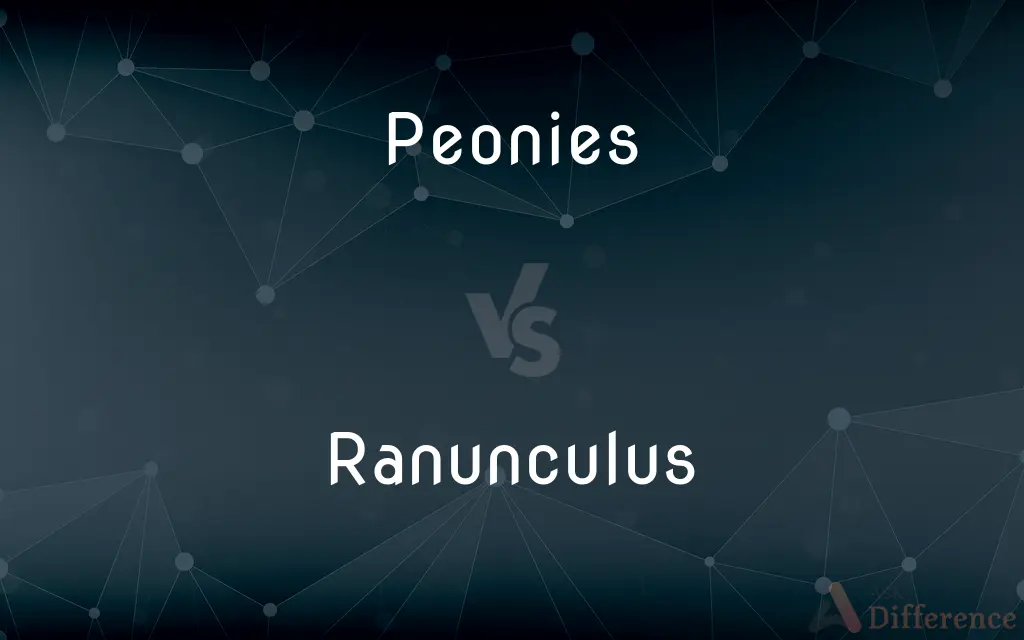Peonies vs. Ranunculus — What's the Difference?
By Tayyaba Rehman — Published on November 23, 2023
Peonies are large, fragrant flowers from the genus Paeonia; Ranunculus are smaller, multi-layered blooms from the Ranunculaceae family. Both symbolize romance, but Peonies also represent prosperity & honor, Ranunculus symbolizes charm & attractiveness.

Difference Between Peonies and Ranunculus
Table of Contents
ADVERTISEMENT
Key Differences
Peonies, originating from the genus Paeonia, are renowned for their large, often fragrant blossoms that can vary from simple single blooms to extravagant doubles. On the other hand, Ranunculus, part of the Ranunculaceae family, are recognized for their multi-layered, rose-like appearance, albeit being smaller in size.
Culturally, both Peonies and Ranunculus have been cherished for centuries in gardens worldwide, but they are distinct in their growth habits and appearances.
While Peonies tend to grow in bushy clumps, boasting flowers that can sometimes reach 10 inches in diameter, Ranunculus sprouts as smaller plants with blooms about 2 to 4 inches across. In the color spectrum, both Peonies and Ranunculus offer a diverse palette.
However, Peonies typically showcase white, pink, and red hues, whereas Ranunculus can surprise enthusiasts with an even broader spectrum, including vibrant oranges and yellows.
Lastly, when it comes to symbolism, Peonies resonate with themes of prosperity, honor, and romance, contrasting with Ranunculus, which primarily embodies charm and attractiveness.
ADVERTISEMENT
Comparison Chart
Genus/Family
Paeonia
Ranunculaceae
Bloom Size
Large (up to 10 inches)
Smaller (2-4 inches)
Common Colors
White, pink, red
White, pink, red, yellow, orange
Growth Form
Bushy clumps
Smaller individual plants
Symbolic Meaning
Prosperity, honor, romance
Charm, attractiveness
Compare with Definitions
Peonies
Symbolize prosperity, honor, and romance.
On her wedding day, she chose Peonies to represent lasting love and prosperity.
Ranunculus
Typically smaller in size, between 2-4 inches in diameter.
Amidst the large flowers, the delicate Ranunculus stood out.
Peonies
Large, often fragrant blossoms from the Paeonia genus.
The garden was filled with the sweet scent of Peonies.
Ranunculus
Popular for their intricate petal structure.
In the flower show, the Ranunculus display was a crowd favorite due to its intricate details.
Peonies
Perennial plants known for their lush petals.
Peonies in full bloom are a sight to behold.
Ranunculus
Symbolize charm and attractiveness.
Giving Ranunculus on a first date might suggest you're charmed by the person.
Peonies
Can be single or double blossomed.
Her favorite are the double-blossomed Peonies for their luxurious appearance.
Ranunculus
Offer a wide color spectrum including vibrant oranges and yellows.
The bouquet was a mix of yellow and orange Ranunculus, radiating warmth.
Peonies
Popular in gardens and floral arrangements.
For the centerpiece, she chose a bouquet of pink Peonies.
Ranunculus
Multi-layered, rose-like blooms from the Ranunculaceae family.
She adorned her hair with a Ranunculus, capturing everyone's attention.
Peonies
Any of various garden plants of the genus Paeonia, having large, variously colored flowers with numerous stamens and several pistils.
Ranunculus
Any of numerous plants of the genus Ranunculus, having yellow or white usually five-petaled flowers, and including the buttercups and the crowfoots.
Peonies
Plural of peony
Ranunculus
Any plant of the genus Ranunculus; the buttercup or crowfoot.
Ranunculus
A genus of herbs, mostly with yellow flowers, including crowfoot, buttercups, and the cultivated ranunculi (Ranunculus Asiaticus, Ranunculus aconitifolius, etc.) in which the flowers are double and of various colors.
Ranunculus
Annual, biennial or perennial herbs: buttercup; crowfoot
Common Curiosities
What is the genus of Peonies?
Peonies belong to the genus Paeonia.
Which is larger, Peonies or Ranunculus?
Peonies are generally larger than Ranunculus.
What is the symbolic meaning of Ranunculus?
Ranunculus symbolizes charm and attractiveness.
Are Peonies fragrant?
Yes, many Peonies are known for their fragrance.
In which colors are Peonies most commonly found?
Peonies are commonly found in white, pink, and red hues.
What colors can Ranunculus come in?
Ranunculus can be found in a wide range, including white, pink, red, yellow, and orange.
When is the best time to plant Ranunculus bulbs?
In cooler climates, Ranunculus bulbs should be planted in spring. In warmer climates, they should be planted in the fall.
Where does Ranunculus come from?
Ranunculus belongs to the Ranunculaceae family.
Which flower is more popular in floral arrangements?
Both Peonies and Ranunculus are popular, but Peonies are often chosen for their larger size and fragrance.
What do Peonies symbolize?
Peonies symbolize prosperity, honor, and romance.
How big do Ranunculus flowers typically get?
Ranunculus blooms are usually 2-4 inches in diameter.
Can both Peonies and Ranunculus be grown in pots?
Yes, both Peonies and Ranunculus can be successfully grown in pots with proper care.
Are Peonies perennial plants?
Yes, Peonies are perennial plants.
How should I care for Ranunculus in a garden?
Ranunculus prefers well-drained soil, full sun to partial shade, and regular watering.
How long do Peonies bloom?
Peonies typically bloom in late spring to early summer.
Share Your Discovery

Previous Comparison
Vitamin B3 vs. Vitamin B12
Next Comparison
Processor vs. CoprocessorAuthor Spotlight
Written by
Tayyaba RehmanTayyaba Rehman is a distinguished writer, currently serving as a primary contributor to askdifference.com. As a researcher in semantics and etymology, Tayyaba's passion for the complexity of languages and their distinctions has found a perfect home on the platform. Tayyaba delves into the intricacies of language, distinguishing between commonly confused words and phrases, thereby providing clarity for readers worldwide.
















































